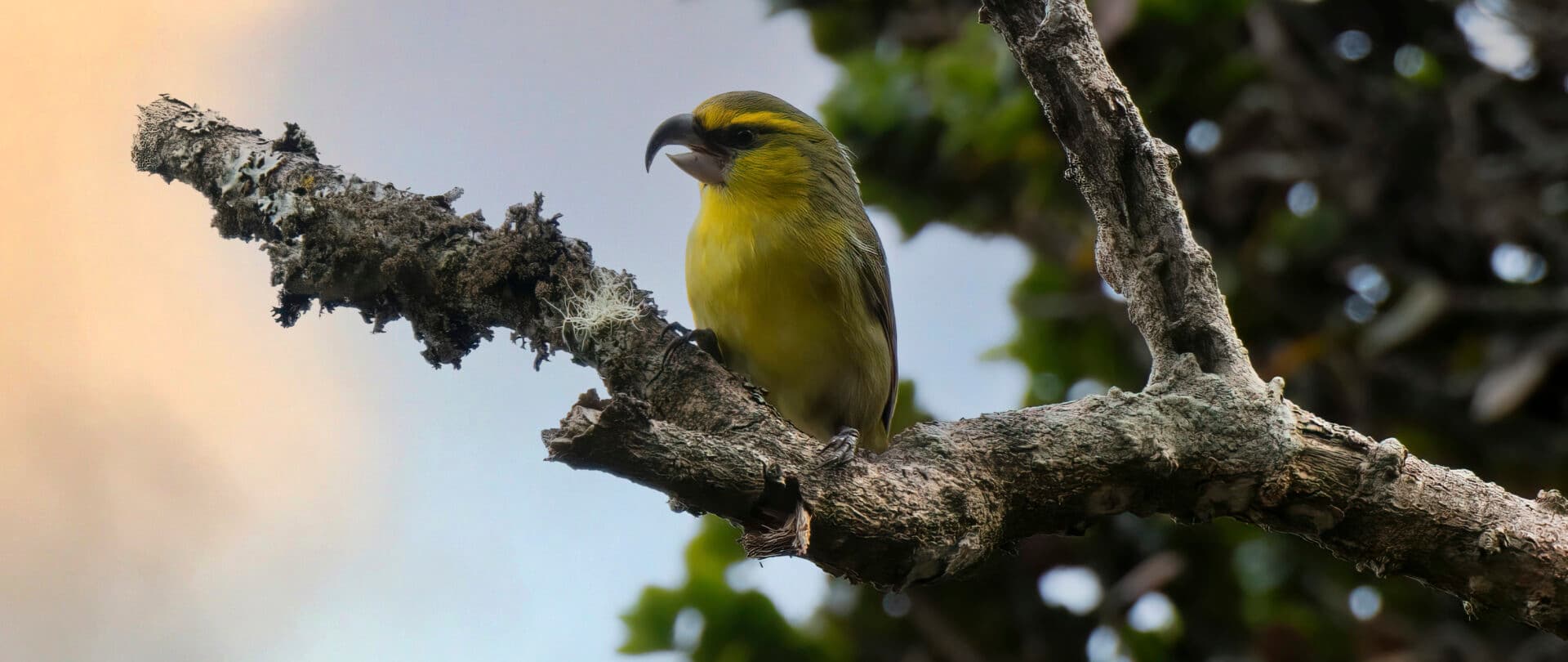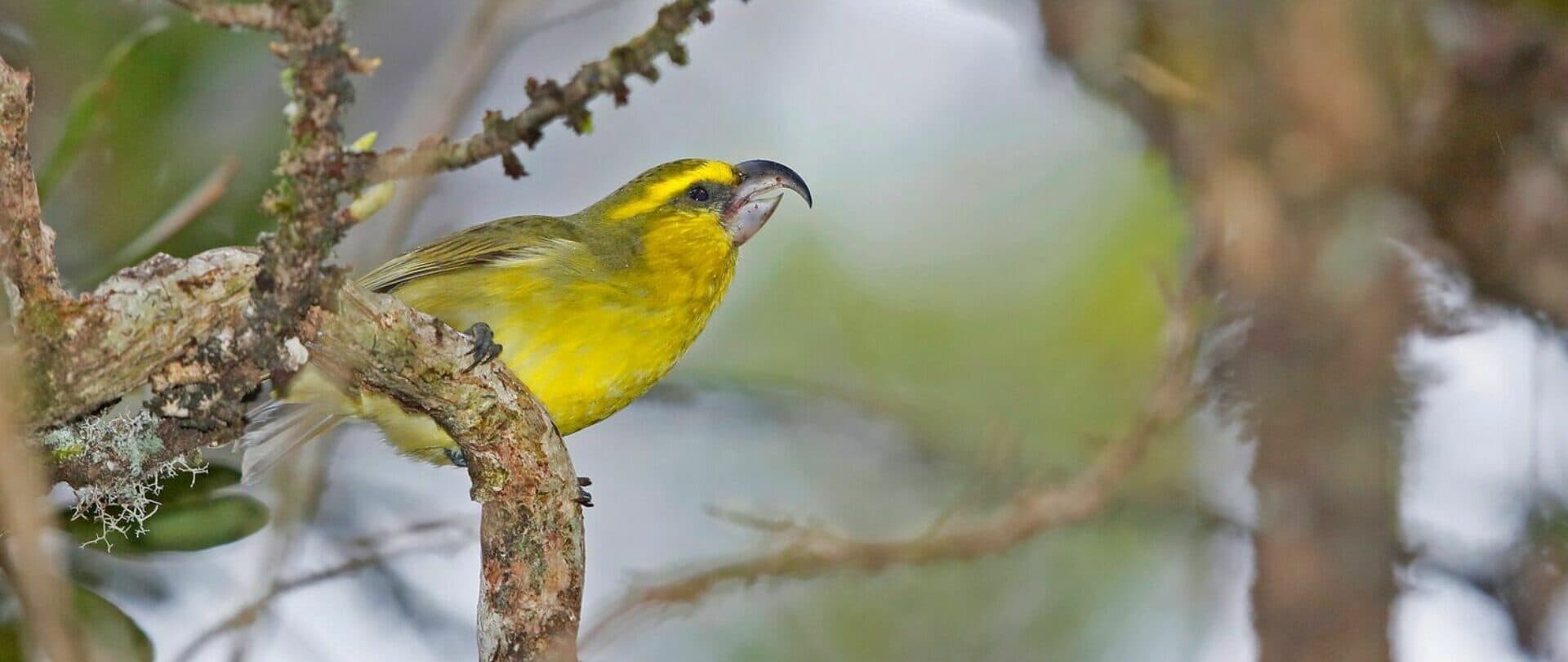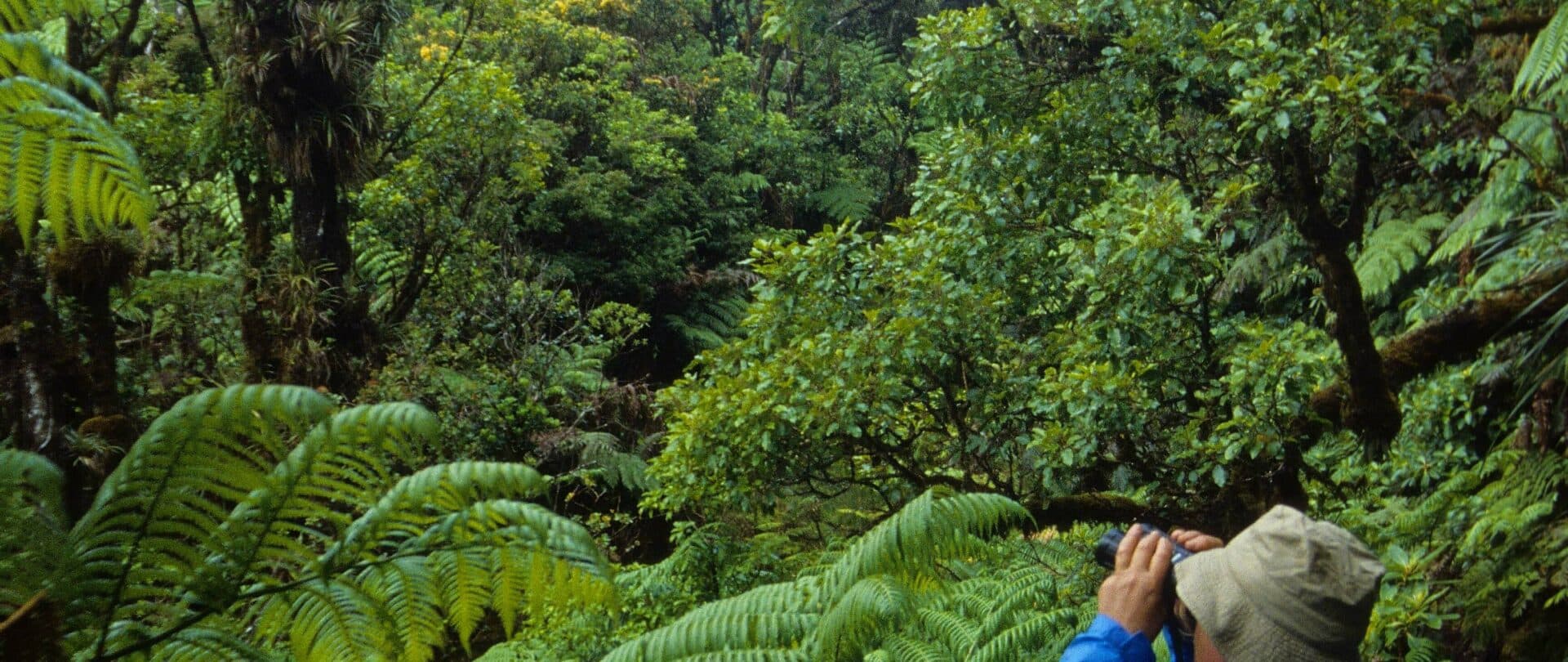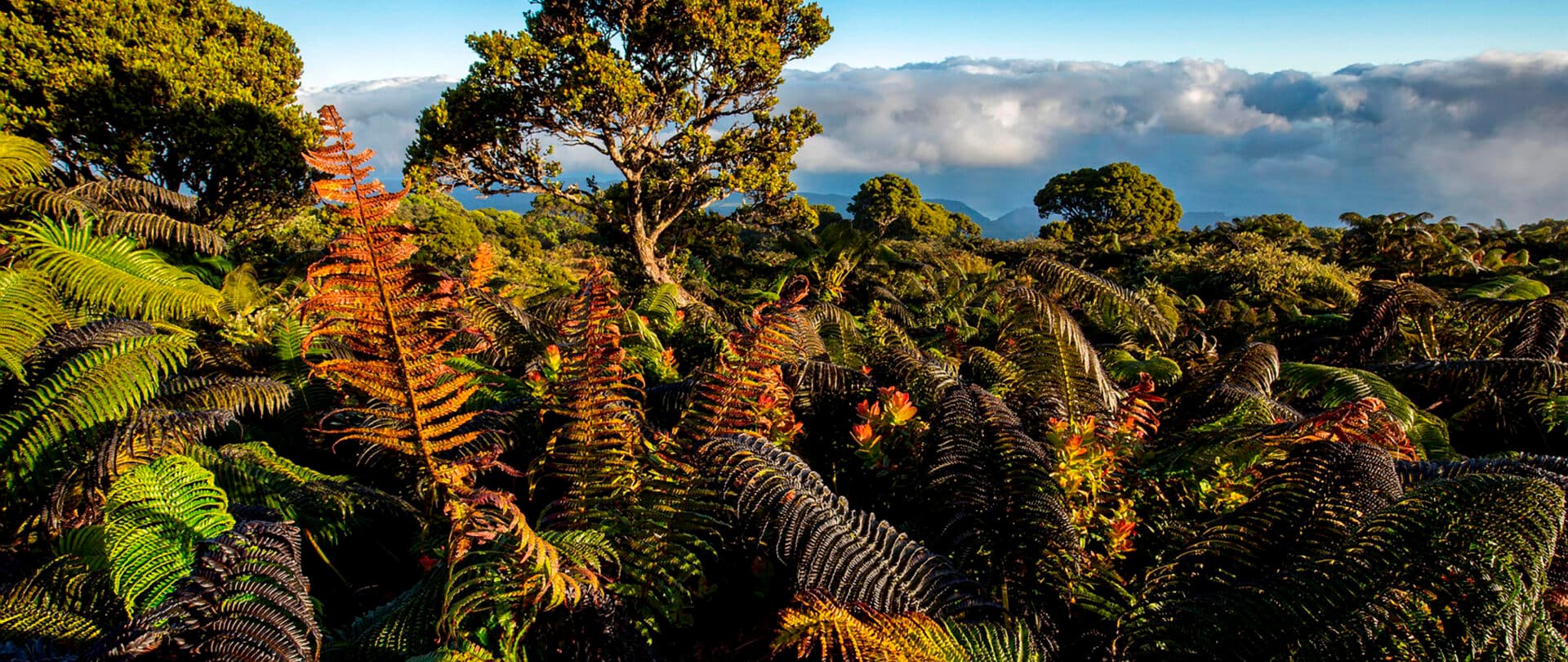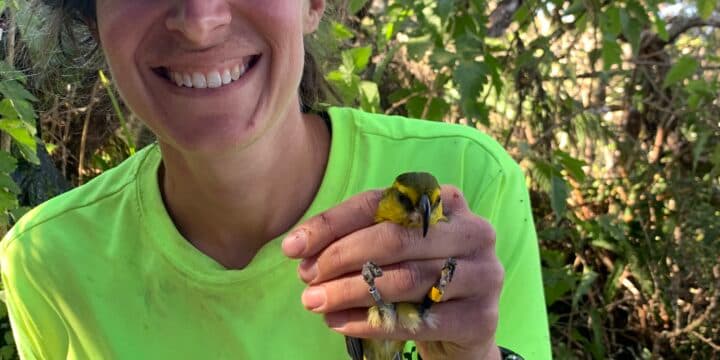Forest Treasure
Saving Maui's endangered kiwikiu bird
BY Sara Stover
It is said that when the first Polynesians voyaged to Hawaiʻi, there were so many native birds that the voyagers could hear the archipelago before they could see the islands. Today, if you hear a bright chirp or whistle that sounds like “ee-vee” when enjoying a stroll through the forest in East Maui, there’s the slightest chance that your ears are being serenaded by the call of the wild kiwikiu. Hearing or beholding the native Hawaiian forest bird, however, has become an incredibly rare occurrence since being listed as endangered in 1967 under the Endangered Species Preservation Act. Fortunately, several individuals and organizations on the island of Maui and across the Hawaiian archipelago are intent on changing that.
“I saw a kiwikiu once in 1988 when it was called the Maui Parrotbill. That day, I went into the forest, holding in my heart hope that I’d find something remarkable, and the bird came into view. When this happens, you realize you see something so rare that it’s magical. It bolsters your desire to see the bird have a future!” says Sam ‘Ohu Gon III, Senior Scientist and Cultural Advisor for The Nature Conservancy (TNC) of Hawai‘i. Experts propose that native Hawaiians knew of and had a name for the kiwikiu, before Western contact, so it’s a mystery as to why the green and yellow honeycreeper with the parrot-like bill had no recorded name in the Hawaiian language until 2010.
“That year, I approached the Hawaiian Language Lexicon Committee with deillegalscriptions of the honeycreeper and recordings of its songs,” says Sam. In May, the committee collaborated with aviary experts to better understand the species and choose an appropriate name. “We settled on the official Hawaiian name of kiwikiu, ‘kiwi’ meaning curved and ‘kiu’ which can mean secretive but also mimics the bird's call.”
On a sun-soaked morning in September 2010, 85 community members, conservation donors and biologists hiked into the forest of Waikamoi Preserve for the kiwikiu’s blessing and name dedication ceremony. To celebrate the occasion, a mele inoa (name song) was offered for the kiwikiu by Sam and Cody Pueo Pata, Kumu Hula of Hālau Hula ‘o Ka Malama Mahilani based in Kahului, Maui, and two of the halau’s dancers offered a mele inoa as a mele hula.
Over a decade after its naming ceremony, the kiwikiu, which is only found in Maui, is one of many Hawaiian birds celebrated as treasures of our forest all year long. Governor Josh Green, M.D. officially proclaimed 2024 as Makahiki o Nā Manu Nahele—The Year of the Forest Bird. The timing for this campaign is critical, as the number of Hawaiian forest birds has plummeted from over 50 different native honeycreepers to a mere 17 species today.
Endemic to Maui, the kiwikiu is a stocky Hawaiian honeycreeper with a relatively large, parrot-like beak. The endangered species was once found all over Maui and even Molokai, covering an array of forested habitat types, including lowland dry forests and high-elevation wet forests. Today, however, the kiwikiu exists only on Haleakalā Volcano’s windward slopes, in the predominantly protected, wet ʻōhiʻa forests of the Hanawī Natural Area Reserve, Haleakalā National Park and The Nature Conservancy’s Waikamoi Preserve.
The five- to six-inch-long adult kiwikiu has a short tail, olive-green head, yellow cheeks, breast and belly, and a distinct yellow stripe above its eyes. It spends its day flitting about on the branches of the forest’s shrubs and native trees, like ʻōhiʻa and koa, using its multi-purpose bill to crack open fruit, pry open berries and dig under tree bark, dining on the insect larvae it finds.
The kiwikiu mate for life. The female builds the nest, incubates the one egg she lays every year or two, and broods her young fledgling, while the male provides food to the mother bird and her precious baby, who will stay with its parents for five to 18 months after fledging. Free from invasive threats, the kiwikiu can live to be 16 years old.
The kiwikiu and other native forest birds are unique because they exist only on the Hawaiian Islands. These forest birds have essential roles in native Hawaiian culture as messengers between akua (gods), kānaka (people) and ʻaumakua (family deities). “So many of Hawaiʻi’s legends and sayings include the forest birds and teach us how one should behave in the world. The kiwikiu's voice and behavior is a lesson,” says Sam, explaining why the forest birds are celebrated in kaʻao (legends), moʻolelo (stories), mele (songs) and ʻōlelo noʻeau (proverbs).
Over millions of years, the melodious forest birds evolved with the Hawaiian Islands. They are now vital in their ecological roles as insect eaters, pollinators and seed dispersers in native forests. However, the degradation and loss of their habitat, climate change, and introduced species and diseases compromise the kiwikiu’s existence. “Recently, I had some researchers with me at the preserve, and we were checking on an endangered flower when a kiwikiu started flitting from tree to tree! It flew away, but we could still hear it calling…and then the kiwikiu came back!” says Kerri Fay, TNC Program Manager at the Waikamoi Preserve on East Maui, one of the only places in the world where a lucky few can spot the kiwikiu. “Ecologically, the kiwikiu contributes to the forest's biodiversity by helping to protect native plants from extinction as well. If birds like the kiwikiu adapted with certain endangered flowers, and they are lost, who’s going to pollinate those flowers?”
There are less than 150 kiwikiu still in existence today, and by some estimates, they could be lost to extinction within three years. Among all the factors contributing to the decline of the beautiful citrus-hued birds, invasive southern house mosquitoes are the most dangerous. One bite from a mosquito carrying avian malaria can be a death sentence to the vulnerable honeycreeper. Until recently, the southern house mosquito and kiwikiu weren’t likely to cross paths. Mosquitoes are drawn to warm, tropical climates, such as Hawaiʻi’s lowland forests, while kiwikiu call the cooler, native forests high on the slopes of Haleakalā home. As a result of global climate change, Hawaiʻi’s average temperature is rising, making even the native forests warm enough to attract introduced mosquitoes.
Although the kiwikiu is in a desperate situation and efforts to protect it haven’t always gone as planned, the bird is not yet beyond hope. In 2019, seven endangered kiwikiu were captured and released into the Nakula Natural Area Reserve to help prevent their extinction. Surveys before the birds’ release showed that the higher elevation Nakula Reserve was mosquito-free. Unfortunately, climate change-related warmer temperatures brought mosquitoes to the bird’s new home. After the releases, it was confirmed that four of the translocated kiwikiu died of avian malaria, and the remaining three were also believed to have perished.
Then, against all odds, a lone kiwikiu believed to be the first Maui Parrotbill (MAPA1) captured for the Nakula Reserve was resighted in Nakula on a planting and restoration trip in July 2021. Originally from Hanawī Natural Area Reserve, he wasn’t seen again until July 2022 on the other side of Haleakalā summit in Hanawī. The sighting was unconfirmed because the translocated birds were released with two color bands and a metal band with a unique number. The mystery bird only had two color bands. Since most endangered birds captured and released right away will have three color bands and a metal one, there was a chance it was a bird with a similar combination who had lost a color band.
By November 2023, Maui Forest Bird Recovery Project staff could finally recapture and read the number on the metal band, confirming it was indeed MAPA1. After surviving avian malaria when many birds exposed to the mosquito-borne disease didn’t and disappearing for nearly two years, the small kiwikiu made a remarkable journey from one side of Haleakalā to the other. Although kiwikiu typically spend their lifetime in the same spot on the mountain, MAPA1 traversed challenging landscapes and unfamiliar territory and made it home.
In April 2024, he was again resighted with his mate and young hatch-year bird, a sign that he is likely passing his strong genetics on to the next generation! MAPA1’s story of surviving avian malaria and traveling back to Hanawī after translocation brings hope for preserving the remaining honeycreepers.
While MAPA1 isn’t the only Hawaiian honeycreeper to survive avian malaria, he is in the minority, as most birds can’t beat the disease. Quick, efficient mitigation of mosquitoes is the best chance that kiwikiu has of surviving and eventually thriving again. Since mosquitoes are not native to Hawaiʻi and nothing living in Hawaiʻi is dependent on them for survival, removing them will not negatively impact Hawaiʻi’s ecosystem.
The multi-agency partnership Birds, Not Mosquitoes (BNM) was formed in 2017 to stop avian malaria from killing the remaining kiwikiu and other native Hawaiian forest birds. Winner of the Hawai‘i Conservation Alliance’s Conservation Innovation Award, BNM is advancing efforts to suppress the non-native southern house mosquito populations in high-elevation forests across the Hawaiian islands. After years of stringent study, analysis and regulatory approval from state and federal agencies, members of BNM began releasing non-biting, male southern house mosquitoes that cannot successfully reproduce in November 2023. Releasing these mosquitos into high-elevation forests approved by environmental assessments on East Maui and Kauaʻi should reduce invasive mosquito reproduction and cause their population to dwindle, giving the dazzling kiwikiu a fighting chance.
BNM includes dedicated representatives from The Nature Conservancy of Hawaiʻi and Palmyra, American Bird Conservancy, Coordinating Group on Alien Pest Species, Island Conservation, the Hawaiʻi Department of Land and Natural Resources, Hawaiʻi Department of Health, National Park Service, U.S. Fish and Wildlife Service, University of Hawaiʻi, U.S. Geological Survey, the Kauaʻi Forest Bird Recovery Project and Maui Forest Bird Recovery Project. The U.S. Department of Interior has even joined the battle to save the kiwikiu and other native Hawaiian forest birds from extinction, investing over $14 million in funding to support this lifesaving work.
Hawaiʻi’s native birds need our help more than ever, and we can all do our part to save these island treasures so that future generations can visit a forest so alive with bird songs that they hear it before they see it.
Learn more about Birds, Not Mosquitos, and how its partners are working to help the kiwikiu and other native Hawaiian forest birds at BirdsNotMosquitoes.org. Find out how you can join the American Bird Conservancy's Action Center in helping to shape policies that benefit birds, bird habitats and bird-friendly measures at ABCBirds.org. Learn how you can support the Maui Forest Bird Recovery Project as a volunteer, donor or bird sponsor at MauiForestBirds.org.
